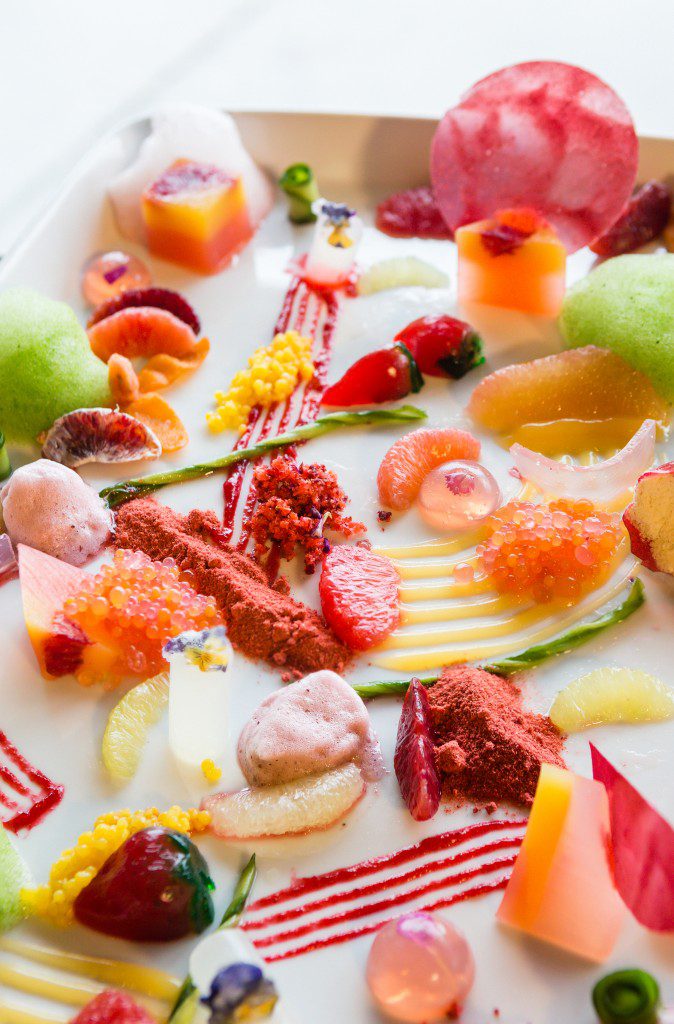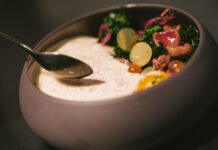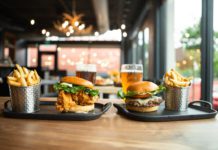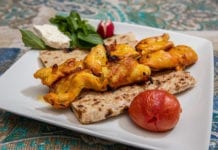
[dropcap]Feb. 14[/dropcap] can be a draggy and depressing day for those without special plans, but this year a select and happy group of Tulsans walked with a spring in their step. That’s because they had been treated, the night before, to a four-hour, ten-course dinner that, though wine was not provided, left them laughing and as bubbly as champagne.
“I’m a firm regular,” one young diner says before the meal begins. Though he’s the sort of elegant hipster who would far prefer to dish out stinging, witty critiques, he has nothing but praise for Kent Monroe, the chef whose monthly dinners, semi-clandestine and spread by word of mouth, drew this crowd together. “I got tickets before I saw the menu. He’s a genius.”
To cheers and applause, Chef Kent comes out. He looks about the same age as Beaver Cleaver’s older brother, and, as he describes the courses to the rapt attentive crowd, you can see the same boyish exuberance. He’s a science nerd. A few amuse-bouches have been shared, including a “salad” whose entire flavor has been compressed into a greenish sorbet (yes, Kent is fascinated by molecular gastronomy), and now the diners can see, in the kitchen beyond, chefs strewing mounds of rare, expensive wild mushrooms into big soup bowls. There’s black trumpet, hedgehog mushrooms and even shavings of white truffles. They then put little mounds of powders beside the mushrooms. Kent made the powders from a stock of button, shiitake, portobello and porcini mushrooms. The bowls are brought before each diner, and a rich creamy broth is carefully poured on. Then you stir. The flavors are sharp, decadently rich, unforgettable.
“Just as you wonder why it’s taking so long,” the hipster says, “you see that beautiful plate and you say, ‘Oh, yeah. That’s why!’”
“At first I thought I’d serve straight mushroom soup,” Chef Kent says a few days later. “Then I got the idea of serving heaps of mushrooms on top of a thick mushroom stock. Then I tried to make the mushroom stock thick and shiny like colored glass, but that didn’t work so I settled for making each stock into a powder.”
He’s eating at Mandarin Taste, a small Chinese restaurant on south Sheridan Road whose dedication to providing rigorously authentic and carefully prepared dishes from all regions of China rivals Kent’s own. He tries a spoonful of spicy pig brains with tofu, and he loves it – “it’s like pork butter!” he exclaims – but he’s so wrapped up in his discussion of food concepts and theory that the food he’s eating takes second place. He once studied astrophysics at Rice University in Houston, and someone asks him how he feels about abandoning science.
“Abandoning science? Never!” Kent exclaims with passion. “Cooking stands at the intersection of all sciences! How can you understand the structure of meat without biology and chemistry? How can you understand cooking without understanding thermodynamics, heat transfer, osmosis, equalization of pressures – and that’s all physics!”
He goes on to provide a long description of how he tried to develop little flavor pearls that would float in liquid.
“It set at 90 degrees, and it wouldn’t float, so I used foam from an aquarium pump, loaded it into a syringe, injected it into each sphere and put it into an ice bath,” he says. “Too much work! Now I’m hoping to buy a chamber vacuum sealer secondhand; maybe I can use that.”
For Kent, planning an entree means solving a succession of science problems, and he loves it even more than eating the entree.

Amazingly, Kent has no formal culinary training whatsoever except for a short stint at Bodean Market.
“Except for my childhood,” Kent corrects. “In a way, I’m a product of World War II.”
His mother is German, his father Japanese. Both his grandmothers remarried, and both of the new husbands were American soldiers. His parents met in California, fell in love and moved to Tulsa where Kent was raised in a house with a huge garden.
“We grew up cooking,” Kent says, “and not typically American food either. We had steak and potatoes once a year. The rest of the time, it was tabouli, sukiyaki, things from all over.”
Perhaps that’s why Kent is fascinated by every method of cooking.
“I’m self-taught, 100 percent self-taught,” he says. “My long-term goal is to learn about every method of cooking and try it at least once.”
You’ll find quite a few of them at the dinners. “Nothing you taste,” counsels one diner, “is what you expect.”
You might find a nest of lurid green sea beans, a salty, smoky coastal delicacy, with a big, bright yellow duck egg yolk in the center, accented by a dollop of bubbly pomelo foam and a yellow scoop of chive gel. You’ve never tasted anything like it and suddenly it’s your favorite dish. Then out comes duck with two sauces, one a shiny white, smoked grapefruit, the other a smoky dark fenugreek. This is followed by steelhead trout swimming amidst two bubbling and flavorful foams, one blood orange and the other pine. A piece of crispy skin shaped like a sail completes the nautical image. Just before dessert there’s a straight steak and potatoes.
“I wanted to serve the steak with cold chawanmushia [Japanese custard flavored with seaweed],” Kent says, “but I had to balance the preferences of my guests against my whims, so I gave them a straight meat course.”
These courses are not easy to plate, and several chefs toil more or less nonstop during the four-hour meal. Joel Bein has volunteered to help. He’s an expert in smoking, and his barbecue truck Rub has deservedly garnered rave reviews and a loyal following. Then there’s Josh Vitt. He doesn’t look much older than Kent, but he’s been in the restaurant business for 22 years after graduating from Florida Culinary Institute. Though today he follows Kent’s lead, Vitt holds pop-up dinners of his own from time to time, and foodies know to reserve a place the moment they hear of them. Josh runs a catering company, and that’s where Kent works during the 28 days each month that the Un-Restaurant is closed. It’s also the location of the Un-Restaurant, but Kent told me that he will be moving these events to Kitchen 66.
“It’s an incubator for food entrepreneurs,” Kent says. Founded, fostered and funded by the Lobeck-Taylor Family Foundation, Kitchen 66 gives would-be restaurateurs what they need to cross the bridge between pipe dreams and a real restaurant: access to a professional kitchen, help with licensing and assistance with planning and pricing. It’s located in the Sun Building, the tall, golden downtown tower built by Sunoco 60 years ago. But all that’s in the future as the Valentine’s dinner draws to a close.
“That chef’s an up-and-comer!” gushes one satisfied customer. She works for oil companies and has tried every Michelin-starred restaurant located in a city with oil, so she knows. Pretty much everyone is gushing and happy by now.
“This is a family reunion with family you’ve never met,” says the hipster.

























